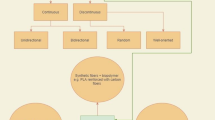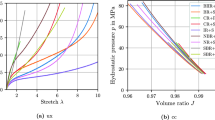The article considers the questions of adequacy of mathematical modelling of relaxation processes of polymer textile materials. The developed integral criteria for confidence prediction of relaxation processes of polymer textile materials are based on minimizing the integral functional-convolution corresponding to the defining equation of state. The implementation of the developed criteria for confidence prediction of relaxation processes of polymer textile materials is possible due to their computerization.



Similar content being viewed by others
References
A. G. Makarov, G. Y. Slutsker, et al., “Initial stage of stress relaxation in oriented polymers,” Phys. Solid State, 58, No. 4, 840-846 (2016).
A. G. Makarov, G. Y. Slutsker, and N. V. Drobotun, “Creep and fracture kinetics of polymers,” Techn. Phys., 60, No. 2, 240-245 (2015).
N. V. Pereborova, A. G. Makarov, et al., “Mathematical modelling and computed prediction of viscoelastic creep in geotextile nonwoven fabrics,” Fibre Chem., 50, No. 6, 487-490 (2019).
N. V. Pereborova, A. G. Makarov, et al., “Methods of simulation and comparative analysis of shadow and deformation-reducing properties of aramide textile materials,” Izv. VUZ, Tekhnol. Tekst. Promysh., 375, No. 3, 253-257 (2018).
A. S. Gorshkov, A. G. Makarov, et al., “Modelling of directed polymers deformation processes based on the description of the kinetics of supramolecular structures separated by energy barriers,” Mag. Civil Eng., 44, No. 9, 76-83 + 103-104 (2013).
A. G. Makarov, N. V. Pereborova, et al., “Quality analysis of deformation-relaxation properties of aramid cords mountain rescue appointments,” Izv. VUZ, Tekhnol. Tekst. Promysh., 368, No. 2, 309-313 (2017).
N. V. Pereborova, A. G. Makarov, et al., “Mathematical modelling and comparative analysis of deformation/recovery properties and shrinkage of aramid textile materials,” Fibre Chem., 50, No. 5, 468-472 (2019).
P. P. Rymkevich, A. A. Romanova, et al., “The energy barriers model for the physical description of the viscoelasticity of synthetic polymers: application to the uniaxial orientational drawing of polyamide films,” J. Macromol. Sci. B, 52, No. 12, 1829-1847 (2013).
N. V. Pereborova, A. G. Makarov, et al., “Methods of increasing the competitiveness of domestic aramid textile materials based on complex analysis of their functional properties,” Izv. VUZ, Tekhnol. Tekst. Promysh., 378, No. 6, 267-272 (2018).
N. V. Pereborova, A. V. Demidov, et al., “Methods of mathematical modeling and qualitative analysis of relaxationdeformation processes of aramide textile materials,” Izv. VUZ, Tekhnol. Tekst. Promysh., 374, No. 2, 251-255 (2018).
A. V. Demidov, A. G. Makarov, et al., “Forecasting of deformation-relaxation properties of poly amide fabric used to make the canopy,” Izv. VUZ, Tekhnol. Tekst. Promysh., 367, No. 1, 250-258 (2017).
A. V. Demidov, A. G. Makarov, and A. M. Stalevich, “System analysis of viscoelasticity of textile stuffs,” Izv. VUZ, Tekhnol. Tekst. Promysh., 298, No. 3, 11-14 (2007).
A. G. Makarov, N. V. Pereborova, et al., “Mathematical modelling of deformation-relaxation processes polymeric materials in conditions of variable temperatures,” Izv. VUZ, Tekhnol. Tekst. Promysh., 370, No. 4, 287-292 (2017).
A. G. Makarov, N. V. Pereborova, et al., “Modelling and forecasting viscoelastic properties of textile materials with a complex structure,” Izv. VUZ, Tekhnol. Tekst. Promysh., 354, No. 6, 120-124 (2014).
A. V. Demidov, A. G. Makarov, and A. M. Stalevich, “The criteria of optimal selection of mathematical model of textile materials viscoelasticity,” Izv. VUZ, Tekhnol. Tekst. Promysh., 293, No. 5, 21-25 (2006).
A. V. Demidov, A. G. Makarov, and A. M. Stalevich, “A version of modeling of nonlinear-hereditary viscoelasticity of polymer materials,” Mech. Sol., 44, No. 1, 122-130 (2009).
A. G. Makarov, N. V. Pereborova, et al., “Ways of modelling deformation and relaxation properties of textile materials with a complex structure,” Izv. VUZ, Tekhnol. Tekst. Promysh., 351, No. 3, 110-115 (2014).
A. V. Demidov, A. G. Makarov, and A. M. Stalevich, “Definition of the computer forecasting trends of deformation properties of textile stuffs,” Izv. VUZ, Tekhnol. Tekst. Promysh., 297, No. 2, 14-17 (2007).
A. G. Makarov, A. V. Demidov, et al., “Modelling and prediction of estimated relaxation and deformation properties of the polymer parachute line,” Izv. VUZ, Tekhnol. Tekst. Promysh., 360, No. 6, 194-205 (2015).
A. M. Stalevich and A. G. Makarov, “Determining the inherent viscoelastic relaxation spectrum for synthetic filaments,” Izv. VUZ, Tekhnol. Tekst. Promysh., 255, No. 3, 8-12 (2000).
A. V. Demidov, A. G. Makarov, et al., “Research of changes of deformation properties of polyester threads depending on twist amount,” Izv. VUZ, Tekhnol. Tekst. Promysh., 292, No. 4, 9-13 (2006).
A. V. Demidov, A. G. Makarov, and A. M. Stalevich, “Definition of the mechanical characteristics of textile stuffs at variable temperature,” Izv. VUZ, Tekhnol. Tekst. Promysh., 291, No. 3, 13-17 (2006).
A. V. Demidov, A. G. Makarov, and A. M. Stalevich, “Definition of the mechanical characteristics of textile stuffs at variable temperature,” Izv. VUZ, Tekhnol. Tekst. Promysh., 294, No. 6, 15-18 (2006).
A. V. Demidov, A. G. Makarov, and A. M. Stalevich, “Predicting the nonlinear hereditary viscoelasticity of polymers,” J. Appl. Mech. Tech. Phy., 48, No. 6, 897-904 (2007).
A. M. Stalevich, A. G. Makarov, and E. D. Saidov, “Relaxation spectrometry of synthetic yarns,” Izv. VUZ, Tekhnol. Tekst. Promysh., 270, No. 1, 16-22 (2003).
A. G. Makarov, “Determining the analytical correlation between the standardized nuclei of relax-ation and creep in textile materials,” Izv. VUZ, Tekhnol. Tekst. Promysh., 266, No. 2, 13-17 (2002).
A. M. Stalevich and A. G. Makarov, “Forecasting the deformation recovery process and the reverse relaxation in polymer materials,” Izv. VUZ, Tekhnol. Tekst. Promysh., 267, No. 3, 10-13 (2002).
A. M. Stalevich and A. G. Makarov, “Forecasting the deformation recovery process and the reverse relaxation in polymer materials,” Izv. VUZ, Tekhnol. Tekst. Promysh., 268, No. 4-5, 15-18 (2002).
The research was financed within the framework of fulfilling the state assignment of the Ministry of Science and Higher Education of the Russian Federation. Project No. FSEZ-2020-0005.
Author information
Authors and Affiliations
Corresponding author
Additional information
Translated from Khimicheskie Volokna, No. 2, pp. 79-83, March-April, 2021.
Rights and permissions
About this article
Cite this article
Makarova, A.A., Klimova, N.S., Pereborova, N.V. et al. Criteria for Confidence Prediction of Relaxation Processes of Polymer Textile Materials. Fibre Chem 53, 137–142 (2021). https://doi.org/10.1007/s10692-021-10254-6
Published:
Issue Date:
DOI: https://doi.org/10.1007/s10692-021-10254-6




